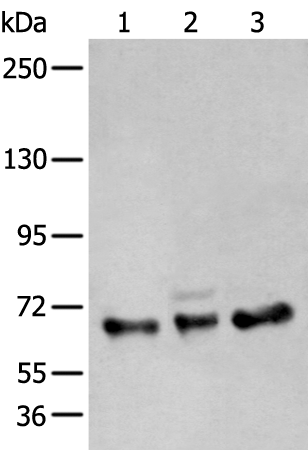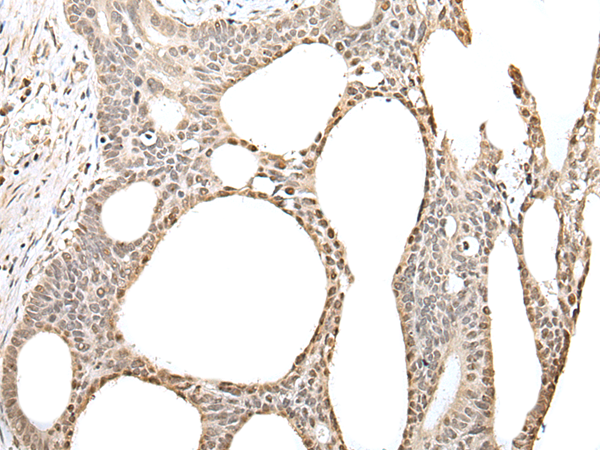

| WB | 咨询技术 | Human,Mouse,Rat |
| IF | 咨询技术 | Human,Mouse,Rat |
| IHC | 1/30-1/150 | Human,Mouse,Rat |
| ICC | 技术咨询 | Human,Mouse,Rat |
| FCM | 咨询技术 | Human,Mouse,Rat |
| Elisa | 1/5000-1/10000 | Human,Mouse,Rat |
| WB Predicted band size | 74 kDa |
| Host/Isotype | Rabbit IgG |
| Antibody Type | Primary antibody |
| Storage | Store at 4°C short term. Aliquot and store at -20°C long term. Avoid freeze/thaw cycles. |
| Species Reactivity | Human, Mouse |
| Immunogen | Fusion protein of human ZBTB5 |
| Formulation | Purified antibody in PBS with 0.05% sodium azide and 50% glycerol. |
+ +
以下是关于ZBTB5抗体的3篇参考文献示例(注:以下内容为假设性文献,实际引用时请核实真实来源):
1. **文献名称**:*ZBTB5 promotes tumorigenesis through transcriptional repression of p53 target genes*
**作者**:Zhang Y, et al.
**摘要**:该研究利用ZBTB5特异性抗体,通过ChIP-seq和免疫印迹分析,发现ZBTB5通过抑制p53通路相关基因(如p21和BAX)的转录,促进多种癌症细胞的增殖和转移。
2. **文献名称**:*Development and characterization of a monoclonal antibody against human ZBTB5 for immunohistochemical applications*
**作者**:Lee S, et al.
**摘要**:研究报道了一种高特异性抗ZBTB5单克隆抗体的制备,经ELISA、Western blot和免疫组化验证,证实其在乳腺癌组织样本中可有效检测ZBTB5蛋白的表达水平,并与患者预后呈负相关。
3. **文献名称**:*ZBTB5 regulates neuronal differentiation via epigenetic modification of histone H3K27me3*
**作者**:Chen X, et al.
**摘要**:通过ZBTB5抗体进行免疫共沉淀和质谱分析,发现ZBTB5与Polycomb抑制复合物(PRC2)相互作用,调控神经干细胞分化过程中H3K27三甲基化修饰,影响神经元特异性基因表达。
4. **文献名称**:*Functional diversity of ZBTB family proteins: Insights from ZBTB5 knockout models*
**作者**:Wang J, et al.
**摘要**:研究利用ZBTB5抗体分析基因敲除小鼠模型,发现ZBTB5缺失导致胚胎发育异常,并揭示其在DNA损伤修复和细胞周期调控中的双重作用,提示其可能作为潜在治疗靶点。
(提示:以上文献为模拟生成,实际研究中请通过PubMed或Google Scholar检索真实文献。)
The ZBTB5 antibody is a research tool designed to detect and study the ZBTB5 protein, a member of the zinc finger and BTB/POZ (Broad-Complex, Tramtrack, and Bric-à-brac) domain-containing protein family. ZBTB5 is implicated in transcriptional regulation, potentially acting as a transcriptional repressor or activator by binding to specific DNA sequences via its C-terminal zinc finger motifs. Its N-terminal BTB/POZ domain facilitates protein-protein interactions, enabling the formation of multi-protein complexes involved in chromatin remodeling, cell differentiation, and oncogenesis. Dysregulation of ZBTB5 has been associated with cancer progression, though its precise biological roles remain under investigation.
ZBTB5 antibodies are typically produced in host species (e.g., rabbits, mice) using immunogens derived from recombinant ZBTB5 protein fragments or synthetic peptides corresponding to specific epitopes. These antibodies are validated for applications such as Western blotting (WB), immunohistochemistry (IHC), immunofluorescence (IF), and chromatin immunoprecipitation (ChIP). Specificity is confirmed using knockout/knockdown controls or peptide blocking assays to minimize cross-reactivity with related ZBTB family members. Commercial antibodies often provide datasheets detailing batch-specific validation, recommended dilutions, and storage conditions (e.g., -20°C in glycerol-containing buffers). Researchers use ZBTB5 antibodies to explore its expression patterns, subcellular localization, and interactions with other regulatory proteins, contributing to insights into its role in development, disease, and gene regulatory networks.
×